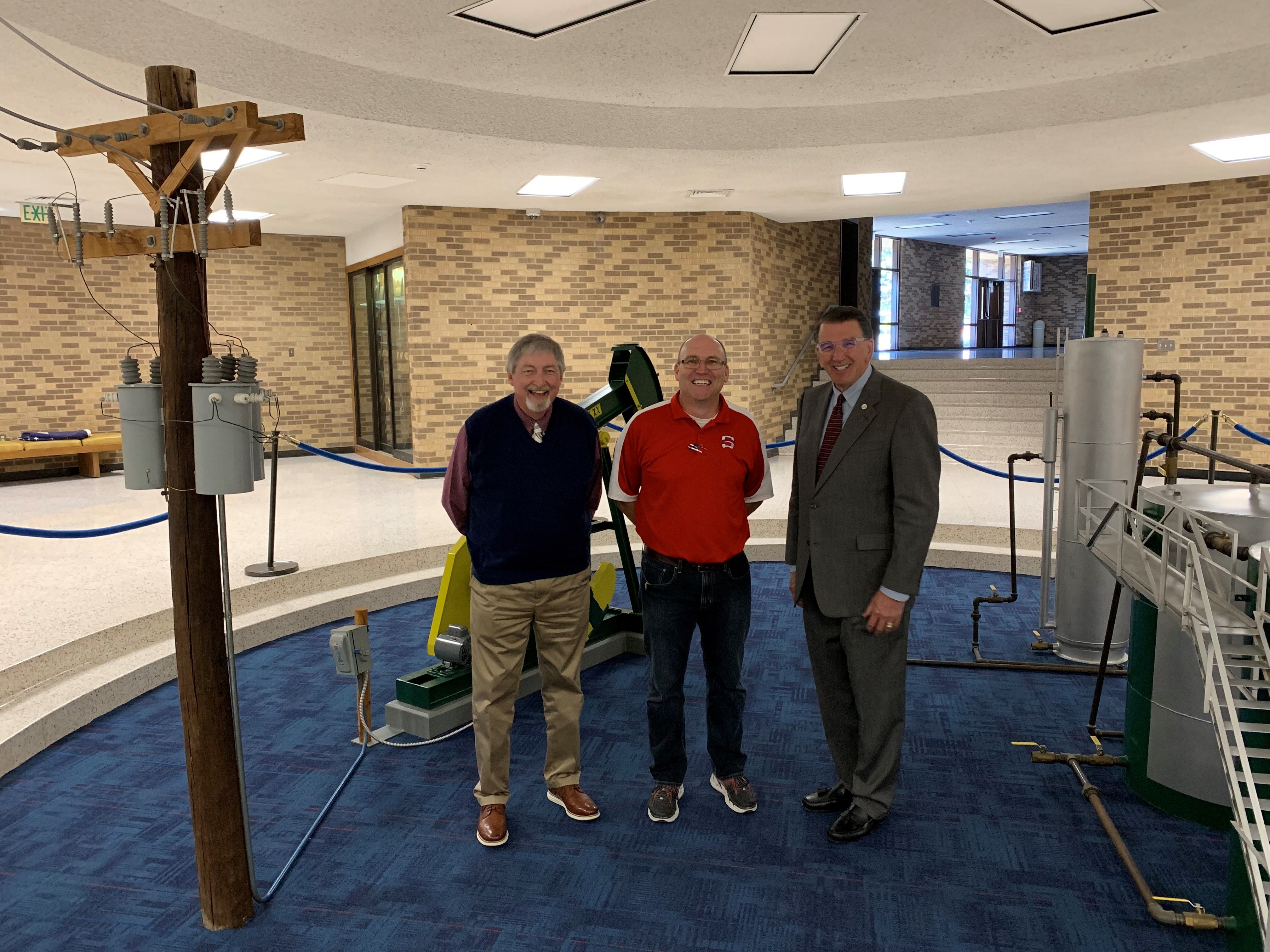 Pictured: Sundown’s rich history in the oil and gas industry is represented through a donated energy exhibit that has been a fixture of Sundown High School since the late 70s. Pictured from left: Bill Craddock, WTAMU Alumnus, Graduate of Sundown High, and former coach and teaching at Whiteface High, Brent Evans, Sundown High School Principal, Walter V. Wendler, WTAMU President.
Pictured: Sundown’s rich history in the oil and gas industry is represented through a donated energy exhibit that has been a fixture of Sundown High School since the late 70s. Pictured from left: Bill Craddock, WTAMU Alumnus, Graduate of Sundown High, and former coach and teaching at Whiteface High, Brent Evans, Sundown High School Principal, Walter V. Wendler, WTAMU President.
Third in a series on what to look for in college.
Whiteface, Texas, is a small community located in Cochran County. Its neighbor, Sundown, Texas, is located in Hockley County. These are both border communities. They lie at the intersection of ranching, oil production and cotton. I found in both communities a sincere commitment to teaching the small number of students who attend high school as Whiteface Antelopes or Sundown Roughnecks.
In addition to the rough geographic borders of oil production, ranching and farming, the borders between adolescence and adulthood exist and are respected in both communities. When talking with students, I queried them to understand their participation in school events outside the normal classroom setting. I may have called them extracurricular activities. In both cases there was nearly unanimous acknowledgment that they were involved in something outside of the classroom and/or work. The border between the academic nature of the high school experience and life’s avocations in workplaces and communities was nearly eliminated. In addition, it appeared to me that teachers sensed the power of this bilateral engagement, and did not see their teaching commitment ending when the bell sounded. Rather, nurturing young people living on the border between adolescence and adulthood was front and center.
This commitment was expressed in different ways by different teachers at both schools, but the recognition that these students were living in “two worlds” simultaneously was apparent. Good teaching recognizes that transitions from one state of being to another are the core of teaching. If the teacher says, “My role is teaching calculus or history, and that’s where the teaching stops,” that’s instruction, a necessary aspect of teaching, but only one aspect. Teachers in Sundown and Whiteface seem to understand the “border existence” between one phase of life and another.
Nothing creates better teaching than an understanding of the border condition. That border condition produces aspirational ethics. Those ethics and motivations provide determination for students to cross the border. To become something they are not. An aspiring architect or engineer or teacher inculcates an understanding of moving forward with the necessary skills and insights. Nurturing teachers do that.
Teaching is a special vocation requiring a powerful connection between teacher and student on a sustained basis. That is what I saw in Whiteface and Sundown. Tireless love to navigate challenging transitions. That is teaching. Questions, concerns, fears, trepidations and a host of other grit that gets placed in the machine of progress must be addressed. Teachers appreciating that challenge will care for the individual in that borderland existence between what is and what will be.
Someone might ask, “You saw all of that in Whiteface and Sundown?” I would say, “Yes, that and more.” As students cross that bridge between being a high school student and something else, they learn from energetic teaching to accept responsibility for personal action and become emotionally responsible citizens. That is the role of education. And students in Whiteface and Sundown expect that. Those high expectations lead to changed views of the world and the borderland allows perspective to see the world changing.
Lastly, good teachers also sense their roles as leaders. Thankfully, in every school I visited I have found to a greater or lesser extent the importance of leadership and teaching. There is no border between these two. Teaching always requires that a vision be cast. Leading requires the same. No excuses, no lack of funding, no challenge with unprepared students, no placing of blame elsewhere absolve the teacher from being a leader and the leader from teaching. Effective teaching and leadership allow no borders between.
If a student and family visit a university campus and don’t find a strong commitment to teaching, an appreciation for the border between late adolescence and a productive life in a vocation and in citizenship, skip the free lunch and head for the house. Look elsewhere for a place to study. Find a place where the fruit of teaching is realized in its fullest expression as addressing and appreciating the borders.
Walter V. Wendler is President of West Texas A&M University. His weekly columns are available at http://walterwendler.com/.



